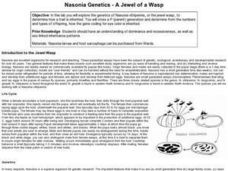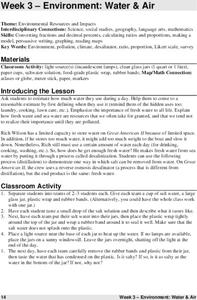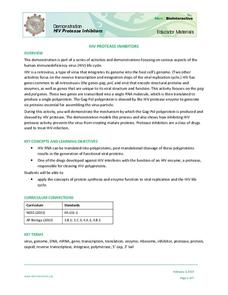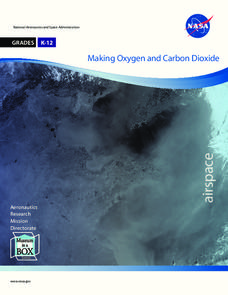Pennsylvania Department of Education
Animal Classes and Their Ecosystems
Students explore animal characteristics by participating in an environment identification activity. In this animal habitat lesson plan, students discuss a range of different wild life and the ecosystems that they are a part of. Students...
Curated OER
Plastic Peas
Students consider the life cycle of certain plastics products and propose improved recycling legislation in their own communities.
Curated OER
Tadpole Diary
Second graders examine the life cycle by observing tadpoles. After reading the book, Tadpole Diary, they draw the stages of tadpole development and write sentences about what they think is happening.
Curated OER
Those Busy, Buzz'n Worker Bees
Students research information on worker bees. In this insect lesson, students review the body parts of insects and how bees find flowers. They discuss compound and simple eyes and the life cycle of a worker bee.
Curated OER
Sequencing Recycling at our School
Students practice sequencing with recycling steps. In this sequencing lesson, students discuss how different materials are recycled. Students paste paper recycling in the order it happens and make their worksheet for the steps in...
Curated OER
Nasonia Genetics-A Jewel of a Wasp
Students investigate the inheritance pattern of eye color in Nasonia wasps. In this genetics and inheritance lesson plan, students read about the life cycle of Nasonia wasps and hypothesize about the possibilities of eye color inherited...
Curated OER
Bringing the Solar System to Life
Students walk marked paths as they simulate the orbit of the planets. In this solar system lesson, students recognize the relationship between the sun and the planets. Students visualize how the phases of the moon are seen.
Curated OER
Caterpillars To Butterflies
Students gain an appreciation of nature by teaching them about the life cycle of the butterfly. They set up a terrarium so they can observe the changes a caterpillar goes through.
Curated OER
Which Baby Animals Looks Unlike Their Parents?
Learners review the steps of the butterfly life cycle to show how the babies are different from the parents. This learning exercise is a graphic organizer with four fill in the blank statements.
Curated OER
Life Processes and Living Things-Humans and Other Animals
For this fill in the blank worksheet, learners respond to 20 short answer questions by identifying foods that contain large amounts of sugar, carbohydrate, and fruit acids and explaining their effects on the body.
Curated OER
Seed Dispersal Quiz
Quiz your kids on how various plants get their seeds dispersed and ready to bloom. They will answer either wind, animal, water, or explosion as a mode of dispersal for the seeds of eight different plants. Tip: Customize this presentation...
Curated OER
Environment: Water & Air
The introduction to the instructional activity mentions a sailor's limited capacity to store drinking water on his ship. Pupils then set up an overnight experiment to remove freshwater from salt water by distillation. There is a math and...
Curated OER
Lifecycle of Painted Lady Butterflies
Students make a chart of the life cycle of the painted lady butterflies that the class observes over a period of several days.
Curated OER
Food Webs
Students are explained that they are spending the next few days researching an organism in preparation for a field trip. They are shown an overhead of the Field Guide. Students discuss what habitat means. They use their organism to...
Curated OER
Are You Aware?
Bring the five senses to life with a fun science experiment! Kindergartners and first graders read an explanation of the five senses, then identify which items Sophia can sense if she is blindfolded. A science explanation at the bottom...
GP Strategies Corporation
Frog Dissection
One of the most common questions in a science classroom is, "Do we get to dissect anything?" With a fun and interactive experience, your eager biologists can perform a virtual dissection on a frog, as well as learn about different kinds...
Howard Hughes Medical Institute
HIV Protease Inhibitors
How do doctors fight a virus that's constantly mutating? Show science scholars how we fight HIV using one of its own most fundamental processes through a thoughtful demonstration. The lesson focuses on how protease inhibitors prevent HIV...
NASA
Making Oxygen and Carbon Dioxide
Some like it hot! Scholars observe both exothermic and endothermic reactions as part of the carbon dioxide oxygen cycle. First, scientists demonstrate (or watch) a chemical reaction to create pure oxygen using fire for...
Curated OER
Butterflies
For this science and reading comprehension worksheet, students read a 1 page detailed passage about butterflies. Students then answer 7 questions.
Biology Junction
Cnidarians and Ctenophorans
Cnidaria is a broad phylum of 11,000 different species from jellyfish to coral. Most Cnidarians are marine species with a few freshwater examples. A lesson presentation explains the important characteristics of different species of...
Curated OER
Changing Planet: Fading Corals
Show the six-minute video, "Changing Planet: Fading Corals," and then demonstrate how calcium carbonate forms a precipitate in the presence of carbon dioxide. Separate your scientists into small groups to gather information about coral...
Sea World
Endangered Species
Study different endangered species with several activities that incorporate math, science, language arts, and research strategies. A great addition to your activity on conservation or Earth Day.
Polar Trec
Animal Monitoring Introduction
Not only do mealworms taste great, they are also great for classroom science lessons. In pairs, young scientists observe and record what they see as they check out what their mealworms are doing from minute to minute. Each minute...
Curated OER
Seasonal Science: Spring Life Science Activities
Spring into science with these great lesson ideas involving butterflies.























